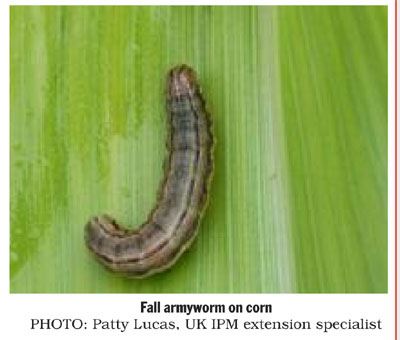UK Insect Pest Early Warning System Benefits Producers
PRINCETON, KY.
For more than 20 years, specialists with the
University of Kentucky Integrated Pest
Management Program have trapped moths
of Kentucky’s major agricultural pests to give
producers an early warning about potential outbreaks.
A recent UK College of Agriculture survey
shows this program is paying financial and
environmental dividends for the agricultural industry.
Fall armyworm moth trap counts at the UK
Research and Education Center in Princeton
reached record numbers on two different occasions
during the summer of 2012. The fall
armyworms arrived in July in Western Kentucky,
earlier than ever before, and were the
largest and longest lasting population in 10
years of data collection. Following the outbreaks,
UK extension entomologist Doug Johnson
and Patty Lucas, IPM extension specialist,
conducted an online survey to determine the
value of the early warning system.
The survey had 39 individual responses representing
24 Kentucky counties and locations
in Illinois, Ohio and Indiana. The respondents
said UK’s early warning system protected more
than $1.6 million in crop yields and saved producers
more than $270,000 in unnecessary
pesticide applications.
Additionally, 12 percent of responders reported
they did not receive the early warning
and lost at least $18,000 in crops due to fall
armyworm damage, because they did not scout
for the pest or make a timely insecticide application.
“It is very clear from these data that early
warning of an insect infestation provides a significant
financial advantage to producers, and
being unaware of early warnings can result in a
significant financial penalty,” Johnson said. “Although
our respondent sample size was small, it
does indicate that the early warnings were used
by a significant portion of agricultural and horticultural
interests, which allowed them to
make on-time, real-time management decisions
for control of this pest.”
The fall armyworm is a pest of many crops including
alfalfa, row crops, tobacco, cucumbers
and tomatoes, but it prefers grasses. The moths
migrate from the South each summer, and the
worms are active in the state from the mid-summer
until the first killing frost. Survey respondents
reported most of the damage from the
2012 outbreak was in grass used for hay and
pastures.
About 85 percent of the 2012 survey respondents
said they received warning about the high
trap counts. Survey respondents listed Kentucky
Pest News, extension specialists, UK’s
Grain Crops Update Blog and county extension
agents as the main ways they received the early
warning.
Of the respondents, nearly 45 percent said,
due to the early warning system, they scouted
their fields and determined they did not have a
fall armyworm problem. As a result, respondents
reported 22,775 acres were not treated
with a pesticide application. This not only saved
producers money but also had human health
and environmental benefits. It reduced the risk
of pesticide exposure to handlers and applicators
as well as beneficial insects including natural
predators and pollinators.

Of the producers who found fall armyworms
in their fields, 47 percent said the early warning
system gave them enough time to make a timely
control decision to prevent crop damage or loss.
Survey participants included producers, consultants,
extension agents, pesticide industry
representatives and farm supply business personnel.
Δ